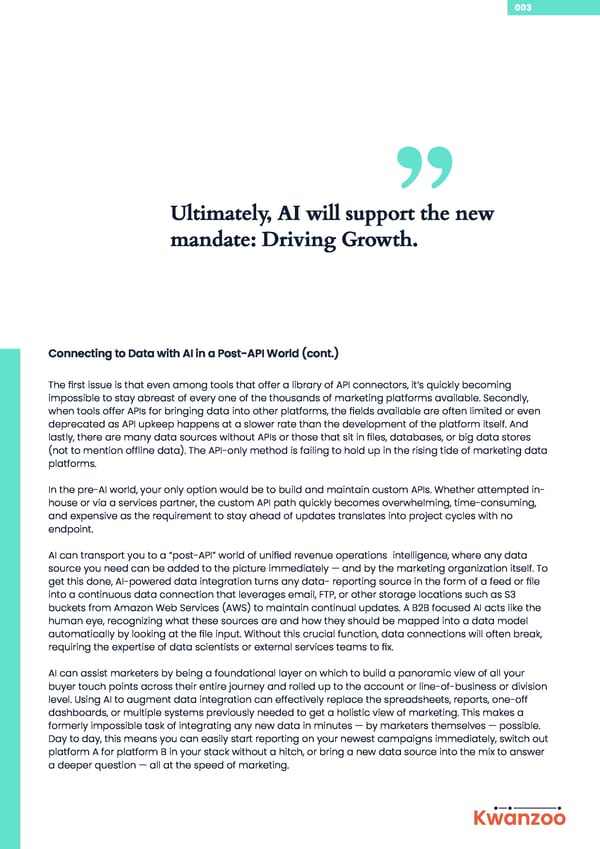003 UltimaUltimatelytely, AI w, AI will suppoill support the nert the new w ” mandamandate: Drite: Driving Gving Grroowth.wth. Connecting to Data with AI in a Post-API World (cont.) The first issue is that even among tools that offer a library of API connectors, it’s quickly becoming impossible to stay abreast of every one of the thousands of marketing platforms available. Secondly, when tools offer APIs for bringing data into other platforms, the fields available are often limited or even deprecated as API upkeep happens at a slower rate than the development of the platform itself. And lastly, there are many data sources without APIs or those that sit in files, databases, or big data stores (not to mention offline data). The API-only method is failing to hold up in the rising tide of marketing data platforms. In the pre-AI world, your only option would be to build and maintain custom APIs. Whether attempted in- house or via a services partner, the custom API path quickly becomes overwhelming, time-consuming, and expensive as the requirement to stay ahead of updates translates into project cycles with no endpoint. AI can transport you to a “post-API” world of unified revenue operations intelligence, where any data source you need can be added to the picture immediately — and by the marketing organization itself. To get this done, AI-powered data integration turns any data- reporting source in the form of a feed or file into a continuous data connection that leverages email, FTP, or other storage locations such as S3 buckets from Amazon Web Services (AWS) to maintain continual updates. A B2B focused AI acts like the human eye, recognizing what these sources are and how they should be mapped into a data model automatically by looking at the file input. Without this crucial function, data connections will often break, requiring the expertise of data scientists or external services teams to fix. AI can assist marketers by being a foundational layer on which to build a panoramic view of all your buyer touch points across their entire journey and rolled up to the account or line-of-business or division level. Using AI to augment data integration can effectively replace the spreadsheets, reports, one-off dashboards, or multiple systems previously needed to get a holistic view of marketing. This makes a formerly impossible task of integrating any new data in minutes — by marketers themselves — possible. Day to day, this means you can easily start reporting on your newest campaigns immediately, switch out platform A for platform B in your stack without a hitch, or bring a new data source into the mix to answer a deeper question — all at the speed of marketing. Kwanzoo
 1. How AI is transforming marketing Page 3 Page 5
1. How AI is transforming marketing Page 3 Page 5